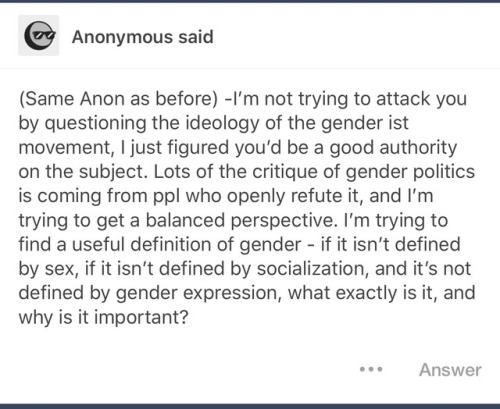avienbgwp:wedontcareaboutyourbinary:wedontcareaboutyourbinary:Sure! The definition of man, as I unde
avienbgwp:wedontcareaboutyourbinary:wedontcareaboutyourbinary:Sure! The definition of man, as I understand it, is “a person who identifies as a man”.
The definition of woman, likewise, is “a person who identifies as a woman.” One thing I think people really frequently get confused about when they hear trans and NB people talking about how the binary isn’t real is that they think we mean that male and female aren’t real. They also think that by “gender isn’t real” we mean gender identity is fake and substanceless and shouldn’t exist. Neither of those things are true. So, let me counter your question about what gender is and how it’s defined, with a comparison: can you define “art” for me?
Would Duchamp’s placement of a urinal or a mass produced snow shovel in an art gallery trouble it? Is a spray painted tag art? Is performance art art? Is my friend’s Instagram of stuff they found on the ground art? What does it mean when you see a sunset and call it art, or watch someone do a badass kick flip and call it art? Does the lack of boundary or definition mean it’s fake and meaningless and needs to be abolished and that all our lives would be better without this fake social construct that is “art”? What’s the point of “art” if Jackson Pollack can just throw paint on a canvas and call it art!! If ANYTHING can be art, then what the hell is art and why do we care about it!! Keep that deconstructionist riffraff out of the museums, they’re mocking this fine ancient institution!! Art is subjective, obviously. It’s a concept that does not exist empirically in nature but becomes art by being viewed by people and examined as art. Just because art is created by passing through a human mind doesn’t mean it’s not real. Which is to say: just because it’s a social construct doesn’t mean it’s not real or significant. My hypothesis is that gender is the same.
Gender IS socially created. Thousands of years of the building of associations and roles created manhood and womanhood as constructs that exist. Other ancient constructs include androgyne, hijra, two spirits, fa’afafine, and the list goes on. Today, we’re in the process of constructing things like agender and genderfluid and demigenders and xenogenders and so on. And they’re real. A person takes a combination of internal experiences (innate feelings) and external experiences (relation to society) and chooses to contextualize them through the lens of gender. The experiences, both internal and external, are real. The choice to contextualize them as gender is valid and real. The choice *not to* is also valid and real. “I choose to contextualize being seen by others as a woman as part of what defines my gender” is a valid choice. “I choose NOT to contextualize being seen by others as a woman as part of my gender” is too. “I choose to contextualize my clothing in relation to my gender” is valid. “I choose not to do so” is valid. “I choose to use my clothing to problematize or defy the boundaries of my gender” is also valid. “I don’t wear these things to be defiant or compliant, I just like them and how they look”, is also valid. In the past we have been given mandates about how we construct our gender, what we must internalize as being part of our identity, and what we are allowed to reject. The “genderist” movement allows us agency over how we construct our individual genders and what we consider part of it. What we aim to destroy isn’t gender identity. What we aim to destroy is rigid, assigned and mandated gender categories as social institutions that control both our identities and our material experiences and opportunities, and our visions of self. In an ideal future, gender is like a name, a career, an aesthetic; a facet of self that is as important or meaningful as you choose for it to be, but that may contextualize how you are meant to be seen by others in the same way that your identity as an artist, an astronaut, a musician, a witch, a punk, a goth is an identity you can take pride in and use to contextualize yourself. They’re not biologically inherent and they’re not socially mandated but they are still allowed to be important and meaningful if that’s what a given individual desires. The problem with gender critical folks, among many other problems, is that they’re incapable of understanding what gender is outside of a system of oppression. They cannot fathom that the feelings that many contextualize as gender are innate and positive for many people. They cannot understand or fathom a world in which manhood and womanhood are not a descriptor of an oppressor state and an oppressed class respectively but simply a neutral construct that we all built together, inside of which one can contextualize oneself. Abolishing the oppressive power dynamics isn’t abolishing the identities. Did that help? — Mod LuneTLDR: Just like art becomes art by being contextualized as art, gender is any number of feelings or experiences that become gender by being contextualized as gender. Art may be “socially constructed” but is still very, very real and value-neutral, and it can be both chaotic and irreverent or of great and significant importance, and gender is like that too. The gender movement is about the destruction of mandated social institutions, and agency in self-defining instead. I’m pretty sure a sunset isn’t art. As broad as the idea of “art” is, it doesn’t encompass things people didn’t create. If you took a photograph of that sunset, then that photograph would be art.This response is art and I think it should go in a fuckin museum -- source link
Tumblr Blog : wedontcareaboutyourbinary.tumblr.com

